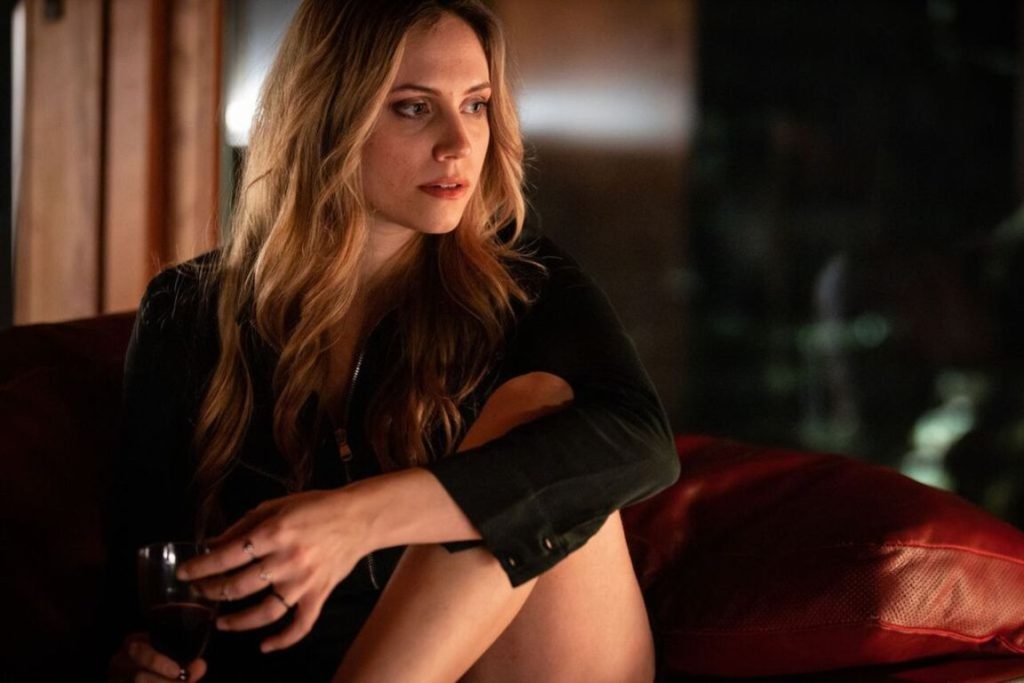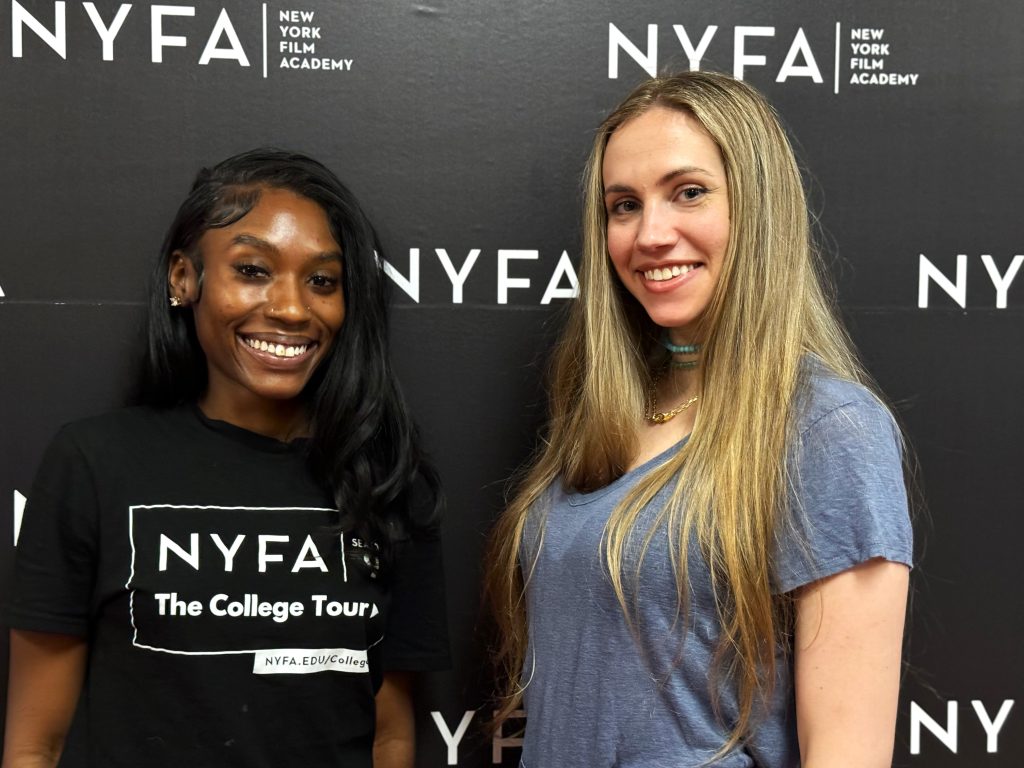It’s Spring, and NYFA Cinematography alum Ilaria Serantoni has graciously made time in her very busy schedule to talk to NYFA. We’re at the Coppola Cafe in Manhattan, and early in our conversation, a woman next to us leans over and asks Ilaria, “May I ask what you’re talking about? It sounds fascinating.”
It turns out that like Ilaria, the woman works in the entertainment industry. The two exchange contact information and Ilaria enthusiastically describes her passion for working in New York City. Since graduating last year from NYFA New York with her MFA, Serantoni, who is originally from Italy, has only expanded her network. She’s worked on several projects as a DP and produced a SAG-AFTRA short film.
In addition to our coffee shop conversation, Ilaria visited NYFA New York to discuss her experience at NYFA, creative process as a Cinematographer, and what she’s been watching.
NYFA: Tell us about your road to NYFA – how did you decide to come to school in the US?
IS: I have always been fascinated by America. After winning a scholarship in filmmaking, I decided to stay and study cinematography. It was a wonderful and exciting journey, incredibly educational.
NYFA: Can you share any memorable moments or experiences at NYFA that influenced your approach to cinematography?
IS: In addition to having a vast amount of technical material on which to practice—cameras, lights, stands—another great source of inspiration is my professor, Piero Basso, who is also the head of the cinematography department and director of photography. He is a great artist capable of inspiring anyone and is a source of inspiration and knowledge. Meeting him was one of the best acquaintances I made in the States.

NYFA: What is your advice to aspiring visual storytellers interested in Cinematography?
IS: Watch both modern and non-modern movies and television series. It is important to have an in-depth knowledge of the film industry.
Read books to enrich your mind and imagination. As a cinematographer, you will always have to deal with scripts. You need the ability to visualize what you read and have the technical experience to make it real on set.
Many cinematographers have worked as gaffers. Working with lights is very important. Light is like water, essential to life. The same applies on set; without light, there is no aesthetics, and the image lacks life. Learning to control light, to diffuse it and direct it, is what makes a director of photography equal to a painter.
On this note, my study in painting and sculpture at the University of Fine Arts in Rome was fundamental for me. It should not be forgotten that all modern cinematography, photography, and visual art are evolutions of classical art from the past. The study of light in paintings, and the use of scenic space, which led to the creation of principles such as the golden ratio, forms the basis of modern cinematography. Based on these principles, you can then experiment.
“This is an industry where you work, and you work a lot of hours.” – Ilaria Serantoni
NYFA: What did you learn at NYFA about Cinematography?
IS: When I arrived at NYFA, my only knowledge was about classical and contemporary art. After studying modern technologies in art at the University of Birmingham – UK – I approached the film industry. NYFA gave me the missing skills to combine all the artistic techniques learned during my studies, which, for me, is fundamental in order to create the visual for every project I work on.
NYFA: What skills did you learn working on real-world projects?
IS: There are things that cannot be learned in school nor taught. Working on a set means collaborating with other professionals in a professional environment. You have to be resourceful, learn through observation, listen to those around you, and become accustomed to working under stress for twelve hours a day. The world of cinema and television series is intense, requiring passion and competence to thrive. Working on set helps you understand if this is truly the path you want to pursue, and if so, it offers valuable rewards: knowledge, connections, and professionalism.
NYFA: How do you approach lighting a scene?
IS: There are many ways to approach lighting, and therefore the emotional, visual, and psychological rendering of the scene. It’s a personal process that varies from artist to artist, but I’ll try to describe mine.
The first time I read the script the images flow before my eyes like in a movie, and from there, I have my first inspiration regarding the lighting and the general mood of the scene.
I work on the lookbook, create sketches, or find reference images to show to the director – in case the project is not mine – with lights and shots.
I work on the script, noting which shots and angles are needed for each scene and character, describing the focal length to use, and the camera movement – still, push in/out.
After the location tech, I start working on the overhead of the scene; a project of the space seen from above in which I arrange lights, flags, and diffusion. This helps me to be prepared for the shooting day, but it’s just a sketch as everything can change on set.
Having a reference plan is important for your mental clarity and makes you less nervous, even if you end up improvising everything.

NYFA: How do you collaborate with the film crew to achieve the desired visual mood and aesthetic?
IS: It is important to have a clear idea of what you want and good technical competence in knowing how to achieve it. After which, you must communicate the instructions to the crew in a clear, simple, and concise manner.
All departments collaborate in the creation of the image and aesthetics of the project. Working as a cinematographer or director does not mean working only with the camera, lights, and actors, but with color palette, costume designing, production designing—everything that influences the viewer’s subconscious to understand the character without too many explanations.
NYFA: What are your favorite parts about working as a DP?
IS: My academic background lies in fine arts, where I immersed myself in painting and sculpture. Transitioning into cinematography has been akin to embracing a novel canvas—a canvas illuminated not by pigment, but by light itself. Crafting shapes, geometries, and shadows solely through the manipulation of light feels akin to wielding a brush on a blank canvas. This process, to me, is both poetic and wondrous, serving as an enduring wellspring of inspiration.
NYFA: What are your favorite parts about working in the film industry in New York City?
IS: Beyond its breathtaking scenery, New York is a city teeming with opportunities. It serves as a haven for individuals with remarkable tales—those whose ancestors were immigrants, forging their own traditions. The narratives span from natives of New York to those who embarked on perilous journeys, leaving their families behind to call this city home. New York’s essence transcends its skyline; it’s the vibrant tapestry of its inhabitants that renders it truly distinctive.
NYFA: Can you comment on the importance of diversity and inclusion in the filmmaking industry?
IS: I cannot emphasize enough the significance of embracing every individual in any professional domain, irrespective of gender, color, religious orientation, and beyond. Undeniably, there are instances when working as a woman on a set presents challenges. It can be draining, and regrettably, some individuals may not regard your contributions seriously. Inclusion is paramount to bridging these gaps, eventually. Each gender brings distinct qualities to the table, all of which enrich the portrayal of a scene.
NYFA: Tell us about your latest film!
IS: I produced a SAG-AFTRA short film that delves into the theme of motherhood following a relationship breakup. Based on real events involving two significant women in my life, this self-produced project truly embodies independent filmmaking. I think the visuals are beautiful, with well-crafted lighting and performances. However, editing proved to be a time-consuming aspect. It’s remarkable how editing can reshape a story. While addressing continuity errors during the process, I seized the opportunity to rethink the project’s direction, resulting in a more compelling narrative. I’m eager for it to be showcased at upcoming festivals.
“It’s good to know the themes inside of your movies…. if you’re making a movie about women, go to FilmFreeway and see the festivals specific about women…that can help you develop a strategy to get your film out there.” – Ilaria Serantoni
NYFA: What can you tell us about your experience preparing your short film for festival submissions?
IS: It’s a process that demands time. I believe the most pivotal aspect lies in the final outcome of the product—being content and having crafted something deemed worthy of viewing. Once that’s accomplished, the focus shifts to identifying suitable festivals for participation. It’s crucial to grasp the categories your film falls under and then seek out festivals that align with those themes.
NYFA: How has the film and editing process changed in the last five years?
IS: Instagram, TikTok, fast news and TV series are influencing the minds of viewers. The information is processed faster, and for this reason, it is right that the editing of the film, or the visual, goes hand in hand with evolution. Of course, it doesn’t mean that every film has to be frenetic and fast. The slow arthouse film still exists, and thank goodness for that. But if we are talking about more mainstream products, the editing is definitely faster, with cuts in the middle of an action that sometimes we don’t even notice but which draws the eye to the screen.
“At the end of the day, Cinematography is [about the] subconscious message.” – Ilaria Serantoni
NYFA: What are some of your favorite films and television shows (in terms of the best Cinematography?)
IS: In my list of TV series that have inspired me from a cinematic point of view, I would definitely include Euphoria, Mr. Robot, The Handmaid’s Tale, and Succession.
When discussing films, notable cinematographers and their works come to mind: The Neon Demon (Natasha Braier), Hero (Christopher Doyle), and The Last Emperor (Vittorio Storaro).
NYFA: What are some examples of films and television shows released in 2023/2024 that best show the future of Cinematography?
IS: Certainly, when it comes to movies, I would definitely mention All Quiet on the Western Front, Poor Things, Killers of the Flower Moon, Oppenheimer, and Saltburn.
Regarding TV shows, I’m genuinely pleased with the overall quality of cinematography in the majority of recent releases. Shows like The Boys, Breaking Bad, Sex Education, and many others stand out not only for their cinematography but also for their storytelling—which is beautifully reflected in the lighting. I believe the future of cinematography lies in TV shows that tackle real societal problems of the modern age.
Want more recommendations? See our Best in Cinematography list on Letterboxd!
Get Hands-On Cinematography Experience at NYFA
Cinematographers like Ilaria set the mood of a film or television show. In the degree and certificate programs at our Cinematography School, aspiring visual storytellers learn how to use moving images, sound, and lighting to tell a captivating story through real-world production experience. Ready to learn more about studying at NYFA? Explore our Cinematography programs today!
Stay posted on Ilaria’s work on her official website. This interview was held over the course of two conversations and edited for clarity. Header image via blackewhite.com.